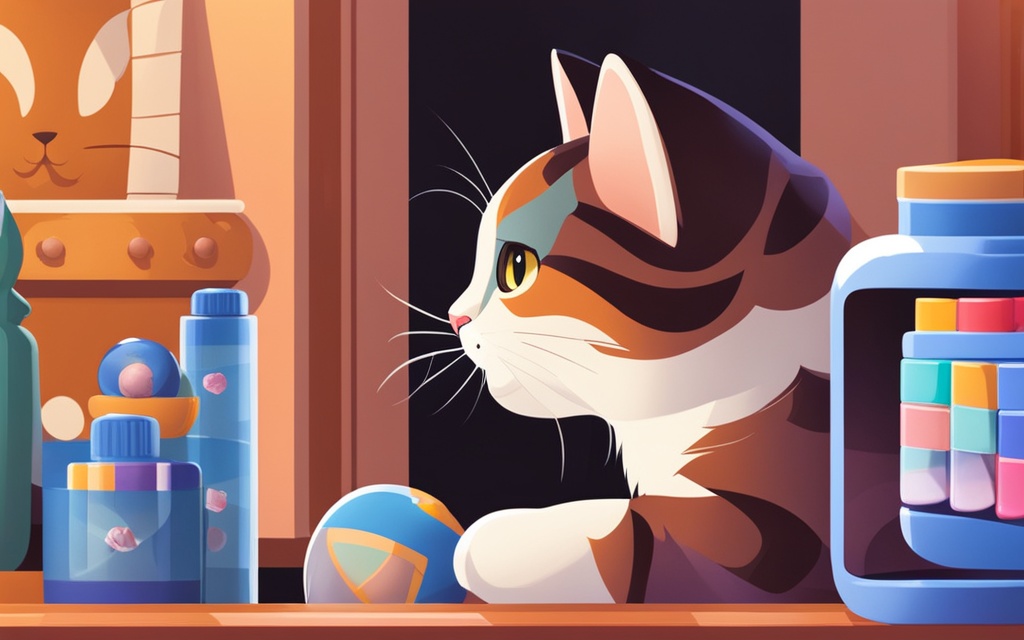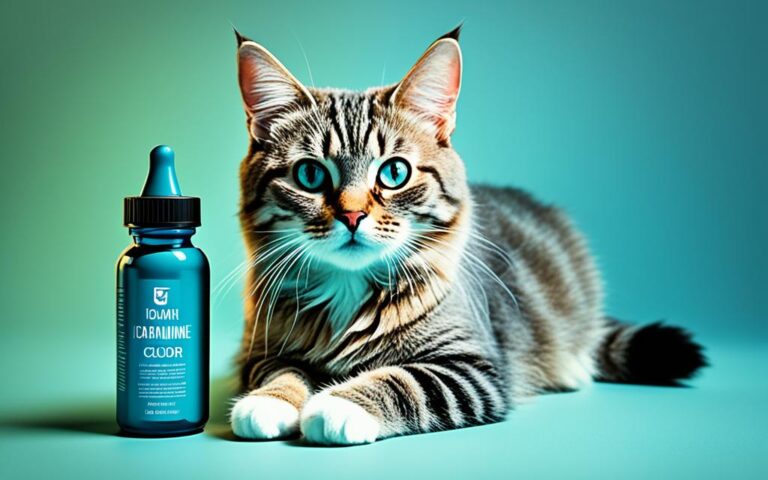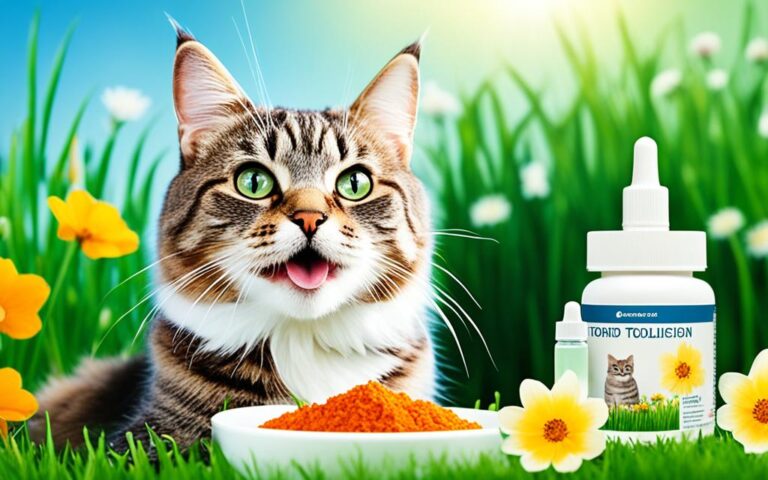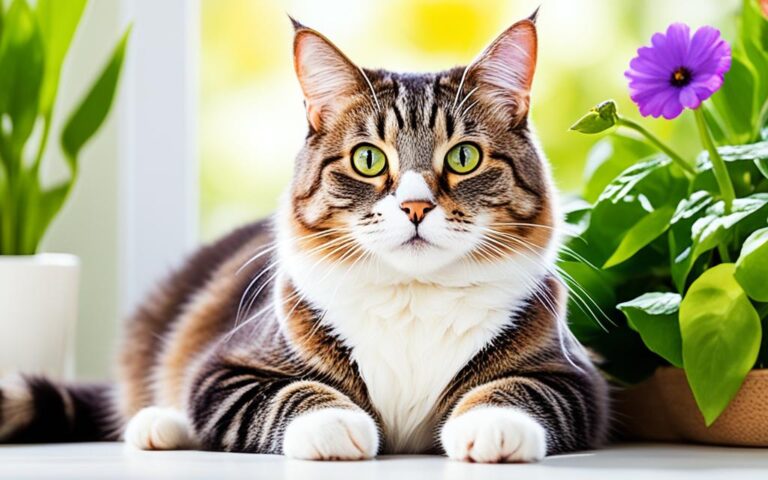Glipizide for cats: Usage, Dosage, and Side Effects
Around 30% of cats with diabetes may do well on Glipizide. This medicine lets them skip insulin shots1. Glipizide (also known as Glucotrol®) treats type 2 diabetes in cats. It’s used ‘off label,’ which means it’s not FDA-approved for pets, but it’s a common treatment2. It comes in a tablet that’s given with their meal. Glipizide spurs the pancreas to make more insulin. This action helps lower the cat’s blood sugar levels3.
Normally, insulin shots are the go-to for diabetic cats. But glipizide is a good alternative for some. It’s best for cats that can be watched closely, have not-so-bad symptoms, and are not very sick3. This medicine isn’t for dogs because their diabetes is different3.
Key Takeaways
- Glipizide is an antidiabetic medication used off-label to treat type 2 diabetes in cats.
- It works by stimulating the pancreas to produce more insulin, helping to lower blood sugar levels.
- Glipizide can be a useful option for certain diabetic cats that can be closely monitored.
- Common side effects include gastrointestinal upset, low appetite, hypoglycemia, and liver problems.
- Glipizide should be stored at a controlled room temperature between 68–77 F.
Table of Contents
What is Glipizide?
Understanding the Drug and Its Purpose
Glipizide is a drug for type 2 diabetes in people. It makes the pancreas release more insulin4. Although not for animals, vets use it off-label to treat some diabetic cats4. This helps cats still producing insulin and watched closely by a vet.
It comes in 5 mg tablets for cats to take twice a day with meals5. Vets need to check your cat’s blood before starting glipizide5. After a few months, it might not work well, so some cats will need insulin5.
Around 50% of cats with a certain type of diabetes get better with this drug6. Only a few cats might get side effects6. You should see if the drug helps within 4 to 6 weeks6. But, the cat must still make some insulin for glipizide to work6.
“Glipizide is a useful drug for managing feline diabetes in certain cases, but it requires close monitoring and may not be effective for all cats.”
Glipizide for Cats: Usage and Administration
Glipizide is an important oral drug for treating feline diabetes. It’s often given to cats with type 2 diabetes. That’s when their pancreas makes insulin, but their body can’t use it well7.
This drug is usually given in a tablet. The right dose for cats is between 0.25 to 0.5 mg/kg. It’s given twice a day, with or after meals8. Know that it might take 4 to 8 weeks to see the full effect. So, your vet should check on your cat’s progress, especially in the first month of treatment9.
Sometimes, Glipizide won’t be the best choice for every diabetic cat. It’s not good for cats that really don’t make insulin or have severe diabetes. A vet will decide if Glipizide works well for your cat based on how they respond to treatment7.
Surprisingly, 30% of diabetic cats can be managed just by taking Glipizide. They might not need insulin shots7. Remember that what your cat eats is critical too. Diets low in carbs are important for their treatment7.
Glipizide is a good option for some cats, but it can have side effects. About 15% of cats might get an upset stomach. And there’s a chance of having low blood sugar in 15% of cases9. It’s vital to have regular vet check-ups while your cat is on this medication.
Glipizide Dosage for Cats
Dosage Chart and Frequency Guidelines
Glipizide is a common medicine for feline diabetes. It starts at a low dose. Then, it’s adjusted based on how the cat reacts and their blood sugar1011. Usually, cats get 2.5-5 mg twice a day10. But, some need up to 10 mg twice a day to control their blood sugar well10.
It’s key to give glipizide with food. The vet might adjust the dose and how often it’s given. They do this based on the cat’s check-ups and any side effects10. Always follow the vet’s detailed instructions for giving glipizide. This ensures the cat gets the best care10.
| Glipizide Dosage for Cats | Frequency |
|---|---|
| 2.5-5 mg | Twice daily with meals |
| Up to 10 mg | Twice daily with meals |
The goal is to use the smallest effective dose. Then, if needed, the vet may increase it1012. This helps manage diabetes well. And it lowers the risk of side effects1012.
Remember, glipizide isn’t the only option for diabetic cats. Insulin and other drugs may be used. The vet, with the pet owner, picks what’s best for the cat12. They create a treatment plan tailored to the cat’s needs12.
Missed a Dose? What to Do
If you accidentally forget a dose of Glipizide for your cat, follow your vet’s advice13. Normally, give the missed dose as soon as you remember. But, if it’s nearly time for the next dose, skip the missed one13.
Never give your cat two doses or more at once. This could lead to hypoglycemia (low blood sugar)14. Giving Glipizide regularly helps control the cat’s blood sugar well14.
Always talk to your vet if you’re worried about missed doses of Glipizide. They will give advice that fits your cat’s situation13. Keeping up good talks with your vet is important for handling your cat’s diabetes treatment right13.
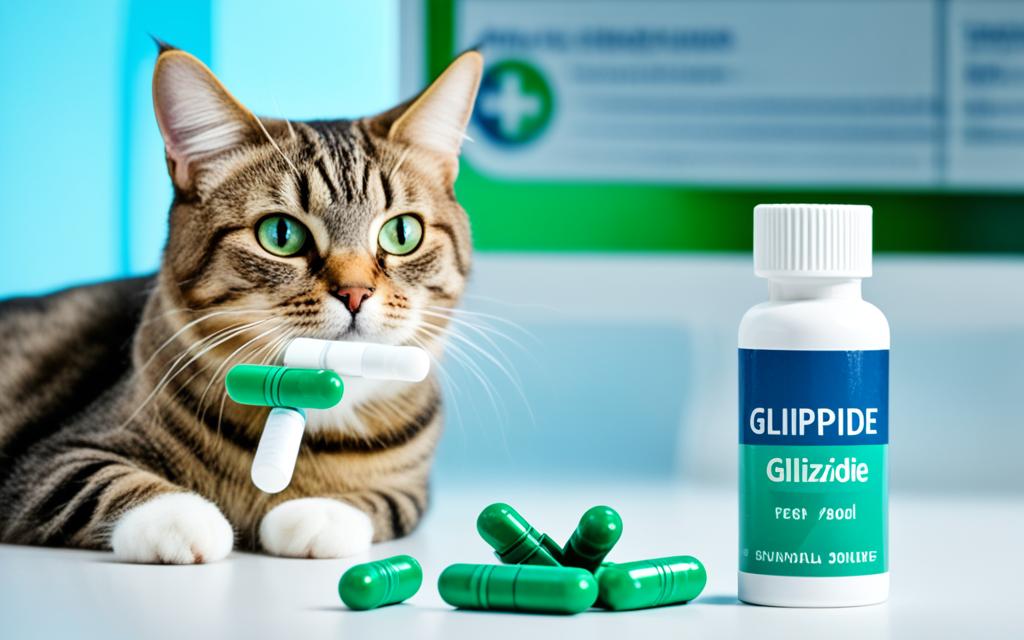
It’s vital to be consistent with your cat’s medication, food, and routine14. Missing a dose or using Glipizide wrong can be harmful13. So, always follow what your vet says very carefully13.
“Missed doses of Glipizide need careful handling to prevent risks for your diabetic cat.”
Have questions or worries? Don’t be shy to contact your vet. They can make sure your cat gets the best care for their diabetes131415.
Potential Side Effects of Glipizide in Cats
Glipizide is good for treating feline diabetes. But, it can cause side effects. The most common are tummy issues like not wanting to eat and throwing up. These issues often go away in 2-5 days16.
Sometimes, the side effects are more severe. This can lead to very low blood sugar or liver issues. The cat might also show signs like not liking their food, being yellow, or keep throwing up. Other dangerous signs include bleeding, feeling warm, having a seizure, fainting, or even feeling very sad. If a cat’s liver or kidneys are not healthy, glipizide should be used carefully. This is because they might have worse reactions, especially blood sugar drops16.
Precautions and Adverse Reactions
Vets will check cats on glipizide closely for bad reactions and adjust the medicine’s dose or stop it if needed16. Pet parents should listen to the vet. They need to tell the doctor right away if they see any strange signs in their cat. Making sure the cat goes for check-ups is very important. This helps the vet keep an eye on the cat’s health and how their blood sugar is doing. Doing this makes glipizide safer and more effective for the cat.
“Diabetic cats should be fed at the same time their insulin injections are administered, as opposed to grazing throughout the day.”16
Taking care of a diabetic cat needs teamwork between the pet owner and the vet. Knowing the risks and how to manage them helps in making sure the cat’s treatment is the right one. This way, the cat gets good care and treatment161718.
Risk Factors and Contraindications
Using Glipizide in cats means understanding its risks. It’s used to treat feline diabetes but with care19.
Type II diabetes is common in cats, with obesity as a big risk factor. The chances of getting diabetes are 1 out of 100 to 1 out of 500 for cats. This number has grown over the years19. Cats who are overweight have a much higher risk, up to four times more, compared to those of normal weight19.
Cats shouldn’t take Glipizide if they’re allergic or have certain health issues like diabetic ketoacidosis. It should be avoided in cats with low blood sugar or debilitated conditions. Pregnant, nursing, or cats with certain diseases should also avoid it. These diseases include those of the adrenal, thyroid, kidney, or liver. It’s also risky in cats who throw up a lot or have a fever19.
Vets will look at a cat’s full health picture to see if Glipizide is right. They might choose other treatments like insulin if needed, depending on risks20.
| Risk Factor | Description |
|---|---|
| Obesity | Obese cats are up to four times more likely to develop diabetes than cats of ideal weight19. |
| Age | Cats aged 10 to 15 years are 49 times more likely to develop diabetes than cats younger than 1 year old20. |
| Gender | Male cats are at a higher risk for diabetes than females20. |
| Breed | Burmese cats have a four-fold risk for diabetes compared with domestic shorthair cats20. |
| Weight | Weight greater than 5 pounds in male cats increases the risk for diabetes significantly20. |
Knowing Glipizide’s risks helps vets choose the best care for cats with diabetes. It ensures their health and safety21.
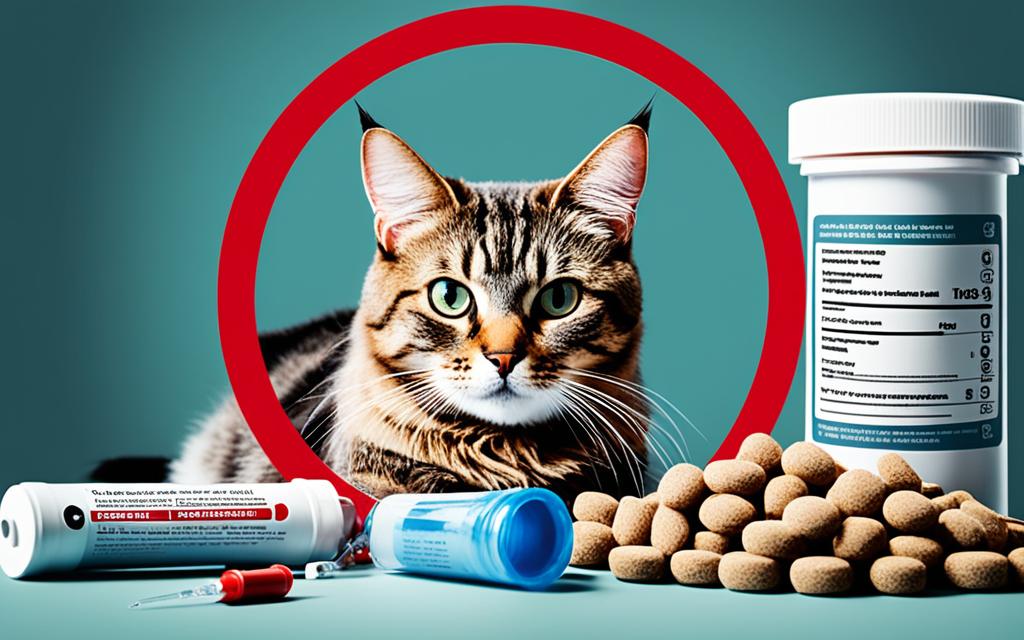
Drug Interactions with Glipizide
Glipizide is often used to help manage feline diabetes. But, it can have interactions with many other drugs22. These interactions might make the drugs work less well or cause more side effects. Pet owners should always tell their vet about any other medicines, supplements, or herbs their cat takes. This is to make sure glipizide is used safely and effectively.
Many drugs can interact with glipizide. This includes alcohol, certain antifungals, and more22. These interactions happen in different ways. For example, some drugs can work together to make an effect stronger. Others can slow down the breakdown of a drug, or they can bind to it in the stomach.
Aceclofenac and albiglutide are drugs that might make glipizide stronger. This could raise the risk of hypoglycemia23. But, atazanavir might make glipizide not work as well. This could lead to high blood sugar23. It’s very important to keep an eye on your cat’s blood sugar levels when they’re taking glipizide with other drugs.
Even some herbal supplements, like anamu and cinnamon, can interact with glipizide. They might make it stronger, increasing the risk of low blood sugar23. There are also drugs like clozapine that can have a bad effect on glipizide’s benefits. This means you need to closely watch how your cat responds to glipizide.
The use of glipizide for cat diabetes hasn’t been studied a lot24. But, it has shown that it can help control blood sugar and lessen diabetes signs in cats24. The chance of low blood sugar from drugs like glipizide for people with type II diabetes is about 2% to 4%24.
To wrap it up, knowing about possible drug interactions with glipizide is key. This helps in the safe and effective treatment of feline diabetes. Talking to your vet often and watching how your cat reacts to the treatment is crucial.
Monitoring and Veterinary Checkups
Importance of Regular Monitoring
Managing feline diabetes means keeping a close eye and visiting the vet often. When starting on glipizide, weekly vet visits are needed. These check-ups include physical exams, weight checks, and lab tests for the cat’s blood sugar25. It helps the vet see how the medicine is working and if any changes to the dose are necessary.
Keeping a cat healthy with glipizide means visiting the vet a lot and watching for any unusual changes. It’s important to keep the blood sugar at the right level for the cat’s health. Owners and vets need to keep a close watch and be ready to make changes to the treatment as needed25. This includes making sure the cat isn’t showing any bad reactions to the medicine.
- Regular physical exams and weight checks to monitor overall health
- Frequent blood work and glucose testing to assess blood sugar levels
- Adjustments to medication dosage as needed based on test results
- Vigilance for signs of side effects or changes in the cat’s condition
Working with the vet and carefully watching the cat’s blood sugar levels and response to glipizide is key. This teamwork helps ensure the cat is getting the best care for its diabetes2526.
| Metric | Normal Range | Diabetic Range |
|---|---|---|
| Blood Glucose | 80-120 mg/dL25 | Up to 300 mg/dL2526 |
| Glucose Curve Test | Every few months25 | Every 2 hours for 12 hours25 |
| Insulin Concentration | N/A | 40 or 100 units per cc/ml25 |
Veterinarians and pet parents need to watch the cat’s blood sugar and health together. With glipizide or other treatments, they can manage the cat’s diabetes safely and effectively2526.
“Proper management of feline diabetes requires diligent monitoring and proactive care to ensure the best possible outcomes for the cat.”
Proper Storage of Glipizide
Glipizide is key in treating feline diabetes. To keep its power, it must be stored well. Keep Glipizide tablets at room temperature, from 68-77°F. Make sure they’re away from light3. Keep the container closed to stop moisture from getting in27.
Compound Glipizide forms might need different storage. Always follow what your compounding pharmacy tells you3. Keep Glipizide where kids and pets can’t get to it. This prevents them from taking it by accident27.
Good storage keeps Glipizide working right and keeps your cat safe. Stick to the storage tips to make sure your cat gets all the medication’s benefits. Also, it lowers the chance of bad side effects2.
| Medication | Storage Requirement | Reason |
|---|---|---|
| Glipizide Tablets | Room temperature (68-77°F), protected from light | To maintain medication integrity and effectiveness |
| Compounded Glipizide Formulations | Follow instructions from compounding pharmacy | Specific storage requirements may vary |
| Glipizide (all forms) | Keep out of reach of children and pets | To prevent accidental ingestion or overdose |
Storing Glipizide well is key. It keeps the medicine strong and your cat safe. Follow the guidelines to help your cat get better without any bad side effects2.
Glipizide for Cats: Overdose and Emergency Information
Glipizide is a strong medicine for diabetes. In cats, too much glipizide can lower their blood sugar to dangerous levels28. This can be life-threatening. If you think your cat has taken too much, don’t wait. Get them to the vet right away.
Cats who have overdosed on glipizide may show signs like being weak, passing out, having seizures, or twitching. If you find your cat like this, you can help by giving them Karo syrup on their gums27. This might help until the vet can provide care.
It’s key to know that the FDA hasn’t okayed glipizide for use in animals. But many vets still use it for diabetic cats27. Giving too much glipizide can be very dangerous. Always give your cat the right amount as your vet says. And watch them for any bad reactions.
If you think your cat has taken too much glipizide, act fast. Call your vet, a pet poison control center, or get to the emergency vet right away. Quick response is crucial to treat an overdose and keep your cat healthy.
Working with your vet closely is vital when treating your cat’s diabetes. Follow the treatment plan exactly. Watch for any bad signs. Being well-informed and acting early is how you can help your cat the most282729.
Conclusion
Glipizide can help with feline diabetes in some cases. But, it’s not always very effective and needs careful watching by a vet30. }
Research shows it can help about 65% of cats in the first 12 weeks of use. The success rates, though, vary from 25% to 65%, depending on the source31. It’s key to manage the medicine well. This is because some cats might show bad side effects like getting very ill, low blood sugar, or the disease coming back30.
If you’re thinking about Glipizide for your cat, being strict with the vet’s advice is very important. Make sure you know about the side effects, how the drug might mix with others, and what to do if your cat reacts badly. Keeping the medicine stored and handled right is crucial for it to work well and be safe30.
In some situations, Glipizide is a good choice. But, there are insulin types like Glargine that might be better. They seem to help more cats get well, especially if their blood sugar is well controlled after they are diagnosed32. Always talk a lot with your vet before you decide on a treatment. Your cat’s specific needs and how they respond to treatments are really important. This will guide whether Glipizide or something else is the best pick, considering the pluses and minuses.
FAQ
What is Glipizide?
How is Glipizide used to treat feline diabetes?
How is Glipizide administered to cats?
What is the typical dosage of Glipizide for cats?
What should I do if I miss a dose of Glipizide for my cat?
What are the potential side effects of Glipizide in cats?
Are there any contraindications or risk factors for using Glipizide in cats?
Can Glipizide interact with other medications my cat is taking?
How often should my cat be monitored while taking Glipizide?
How should Glipizide be stored?
What should I do if I suspect a Glipizide overdose in my cat?
Source Links
- Mar Vista Animal Medical Center
- Glipizide | VCA Animal Hospitals
- Glipizide for Cats
- Glipizide (Generic)
- Glipizide | Texas West Animal Health
- NIDDM in the cat: treatment with the oral hypoglycemic medication, glipizide – PubMed
- Glipizide and Oral Agents – Mar Vista Animal Medical Center
- Glipizide – an overview | ScienceDirect Topics
- Glipizide (Glucotrol)
- Glipizide: Diabetes Medication For Pets | Medi-Vet
- Glipizide in Veterinary Medicine – Facts and Information | PetCoach
- Therapeutic Goals for Otherwise Healthy Diabetic Cats – WSAVA2004
- Microsoft Word – Glipizide.docx
- Insulin Glargine | VCA Animal Hospitals
- The Animal Medical Center of Fort Oglethorpe
- Diabetes in Cats
- American Association of Feline Practitioners
- Feline Diabetes
- Feline Diabetes: Initial Management
- Diabetes Mellitus in Dogs and Cats – Diabetes Mellitus in Dogs and Cats – Merck Veterinary Manual
- Glipizide Interactions Checker – Drugs.com
- Glucotrol; Glucotrol XL
- Monitoring and Managing Glucose Levels in Dogs and Cats
- Diabetes In Cats | Best Friends Veterinary Center
- Glipizide 5 mg Tablets 100 ct | 1800PetMeds
- Cat Diabetes: Symptoms, Diagnosis, Treatment
- Two New Drugs to Treat Diabetes in Cats—Is One Right for Your Cat?
- Canine and Feline Diabetes Mellitus – WSAVA 2003 Congress
- Feline Diabetes Mellitus Updates on Diagnosis & Treatment

